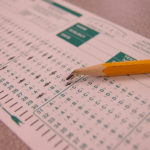Top 10 ACT Tips for Acing the Exam
Although the amount of weight college admissions offices place on standardized test scores will vary between institutions, there is no denying the value a high score on the ACT or SAT will add to a student’s college profile. If you’re planning on taking the ACT, we have 10 great tips to help you ace this critical exam. Wondering what a top ACT score is? We have the answer in our blog ACT score range: What is a good ACT score? A bad ACT score? One of the aspects ACT takers struggle with most is the test’s timing—many students have difficulty completing sections within the given amount of time. In order to get a top score on the ACT, students must balance the need to work quickly with the ability to work carefully. Becoming familiar with the formatting of the ACT, the types of questions asked, and the subject matter tested will all help increase a student’s test-taking speed. Train yourself for better time management by taking timed practice tests and getting accustomed to using a watch to monitor your remaining time. When it comes time to take the real test, bring the watch with you. Here’s a breakdown of the allotted time for each ACT section: The ACT only rewards correct answers; it does not penalize for wrong ones. Consequently, it’s in the best interest of the student to answer every single question on the test—students should go through each section answering the questions they know first, then go back through the section and tackle the more demanding questions. If time is running out in a section and you have unanswered questions, the smart move is to guess—you have a 25% chance of being correct. If you are blindly guessing, pick a random letter (like “D”) and keep plugging it in. If you switch around letters, you’re likely to get less than 25% of the questions correct. The test booklet is not graded and there is no reason not to mark it up and use to your advantage—underline and circle keywords, take notes, use it to make calculations, and cross out answers you know to be incorrect. Alternately, the answer sheet is scored by a machine, so be sure to avoid making any stray marks or scribbles that may fool it. The ACT English test is an assessment of a student’s editing skills—testing their ability to correct the grammar, punctuation, organization, and style of a sample piece of writing. A smart strategy for finding the right answer is to use the four Cs of good writing: complete, consistent, clear, and concise. Often the shortest (most concise) answer is correct, start there and move to the longest answer testing each with the other three Cs. Similarly, be cautious of lengthy answers, as they often correct one problem but introduce another. Get ready for the English section of the ACT with our article A Guide to the English Section of the ACT. Just like the English section of the ACT tests a student’s ability to edit, it also tests their ability to recognize when writing is correct. Although it can be easy for students to talk themselves into finding mistakes that aren’t actually there, “no change” is a viable answer. In fact, if all the answers are distributed evenly, then “no change” should be the answer 25% of the time. The reading section of the ACT consists of four passages always structured in the same order—prose, social science, humanities, natural science—with 10 questions per passage. Consider solving the sections out of order, starting with the field that is most comfortable for the student and ending on the passage of the most challenging field. This allows students to invest their time where it’s most valuable. Learn more about the four passages found in the reading section of the ACT in our blog The 4 Types of Passages You’ll See on ACT Reading. Time is a limited resource in all sections of the ACT, making the time-consuming word problems in the math section especially challenging. A terrific tactic for tackling the math section’s word problems is to get comfortable translating English into mathematical terms—for example, “sum” means addition, “decrease” means subtraction, “of” means multiplication, “quotient” means division—underline these terms along with the numbers in the problem, then pull them from the problem and write the equation in the test book. Want more tips on the Math Section of the ACT? Check out our blog Five ACT Math Mistakes to Avoid. The science section of the ACT contains three distinct types of passages: research summary (three of these occur), data representation (two of these occur), and conflicting viewpoints (1 of these occur). It may be smart to save conflicting viewpoints for last; all the questions are valued the same, and it’s commonly thought that the conflicting viewpoints passage is the most difficult of the three. No need to experiment finding out how to ace the science section of the ACT—read our blog A Guide to the Science Section of the ACT. Complex science terms and jargon can make the research summary and data representation passages of the science section tricky. Rather than getting tripped up by the terminology, skip reading the passage and first look at the provided visuals to answer the question—the majority of the questions ask about information presented there. The ACT generally rewards students who turn in longer essays in the writing section of the ACT (it’s simply difficult to have well-developed thoughts in a short essay). Aim for four to five paragraphs, paying particular attention to the opening and closing paragraphs. Make sure the introductory paragraph contains a clear perspective and thesis while the concluding paragraphs neatly summarize what you’ve written in the essay. Take a step toward a perfect score in the writing section of the ACT by reading our article 5 Tips to Score a 12 On Your ACT Essay. The simplest way to get a great score on the ACT is to simply practice, practice, practice. The sooner a student knows which test they plan to take (the ACT or the SAT), the earlier they can begin preparing. If you end up re-taking the ACT, don’t miss our blog 10 Tips to Improve Your ACT Score. Want to know how your ACT score impacts your chances of acceptance to your dream schools? Our free Chancing Engine will not only help you predict your odds, but also let you know how you stack up against other applicants, and which aspects of your profile to improve. Sign up for your free CollegeVine account today to gain access to our Chancing Engine and get a jumpstart on your college strategy!
1. Be Time Conscious
2. No Risk, Just Reward
3. Mark Up Your Test Booklet
4. Keep it Short and Sweet
5. Don’t Be Afraid of the “No change” Answer

6. Choose Wisely
7. Words, No Problem
8. Structure for Success
9. See the Right Answer
10. The More the Merrier


